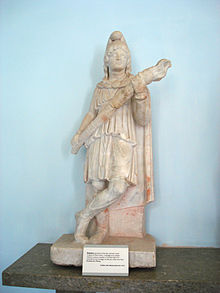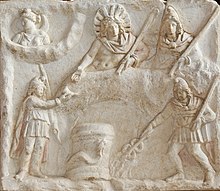31:
22:
53:
155:
280:, tr. Richard Gordon. Edinburgh University Press (2000) p. 95: "No satisfactory etymology of the names Cautes and Cautopates has yet been offered, but it is certain which name applied to which: Cautes holds his torch up, Cautopates down. That it was possible to represent them sometimes simply by their phrygian caps shows that the Mithraists took their presence for granted (p. 49; fig. 9)."
188:
Cautes holds a burning torch pointed up, whereas
Cautopates holds a burning torch pointed down. Cautopates is usually depicted on the left, but not always. They are often shown standing with their legs crossed, but not always.
30:
21:
192:
The two torch-bearers are often interpreted as symbols of light, one for the rising, the other for the setting sun. Cautopates could also represent death, while Cautes might represent new life.
218:
J. Vermasaren shows
Mithras, the unconquerable sun, and his two torch-bearers, Cautes, sunrise, and Cautopates, sunset, equally sized in a 3-branch pine tree, visible at
203:. Thus, represented on the left and right of the Tauroctony, they become a realistic cadre of the celestial equator and the constellations included between the two
60:
52:
138:. If eclipses of the sun and moon formed part of Mithraic symbolism, they could also represent the ascending and descending
369:
344:
195:
An alternative interpretation advanced by David
Ulansey is that Cautes represents the spring
131:
8:
384:
177:
Both are depicted as smaller than
Mithras to emphasize his significance, and both wear
118:
dines. So attendants Cautes and
Cautopates are supposed to represent the stations of
86:. Cautes holds his torch raised up, and Cautopates holds his torch pointed downward.
135:
154:
107:
378:
208:
182:
159:
103:
139:
83:
39:
260:
235:
204:
79:
162:
143:
130:, or equivalently the ascending (spring) and descending (autumnal)
46:, details of the torchbearers Cautes and Cautopates, 2nd century AD
223:
219:
200:
196:
127:
119:
115:
95:
75:
64:
293:, tr. R. Gordon, Edinburgh University Press (2000) p. 95–6.
240:
123:
99:
98:
either represents the sun, or is a close friend of the sun god
43:
178:
185:, to emphasize the supposed oriental origins of the cult.
346:
CIMRM 1247 – Two-sided relief on pivot with side-panels
226:. Vermasaren suggests they form a Mithraic "Trinity".
263:for a fuller discussion. See also Cumont, Franz.
376:
126:respectively, or perhaps the spring and autumn
74:are torch-bearers depicted attending the god
319:, Oxford University Press (1989) p. 62.
328:
78:in the icons of the ancient Roman cult of
153:
51:
59:from a group of Mithras figures in the
377:
317:The Origins of the Mithraic Mysteries
265:Oriental Religions in Roman Paganism
13:
14:
396:
363:
89:
132:nodes of the Sun's apparent path
29:
20:
329:Vermaseren, M. J. (1963),
337:
322:
309:
296:
283:
270:
253:
1:
246:
165:relief. At bottom are Cautes
149:
61:Museo Archeologico Regionale
7:
333:, London: Chatto and Windus
229:
42:fresco in the mithraeum of
10:
401:
199:and Cautopates the autumn
181:style garments, notably a
304:The Roman cult of Mithras
291:The Roman cult of Mithras
278:The Roman cult of Mithras
331:Mithras: the Secret God
174:
68:
158:Banquet scene on the
157:
72:Cautes and Cautopates
55:
140:nodes where the Moon
94:In Mithraic images,
175:
112:the invincible sun
69:
392:
357:
356:
355:
353:
341:
335:
334:
326:
320:
313:
307:
302:Manfred Clauss,
300:
294:
289:Manfred Clauss,
287:
281:
274:
268:
257:
217:
136:celestial sphere
67:, 3rd century AD
33:
24:
400:
399:
395:
394:
393:
391:
390:
389:
375:
374:
366:
361:
360:
351:
349:
343:
342:
338:
327:
323:
315:David Ulansey,
314:
310:
301:
297:
288:
284:
276:Manfred Claus,
275:
271:
258:
254:
249:
232:
215:
169:and Cautopates
152:
92:
50:
49:
48:
47:
36:
35:
34:
26:
25:
12:
11:
5:
398:
388:
387:
373:
372:
365:
364:External links
362:
359:
358:
336:
321:
308:
295:
282:
269:
251:
250:
248:
245:
244:
243:
238:
231:
228:
151:
148:
91:
90:Interpretation
88:
38:
37:
28:
27:
19:
18:
17:
16:
15:
9:
6:
4:
3:
2:
397:
386:
383:
382:
380:
371:
368:
367:
348:
347:
340:
332:
325:
318:
312:
306:, p. 97.
305:
299:
292:
286:
279:
273:
266:
262:
256:
252:
242:
239:
237:
234:
233:
227:
225:
221:
212:
210:
209:Age of Taurus
206:
202:
198:
193:
190:
186:
184:
180:
172:
168:
164:
161:
156:
147:
145:
141:
137:
133:
129:
125:
121:
117:
113:
109:
105:
101:
97:
87:
85:
81:
77:
73:
66:
62:
58:
54:
45:
41:
32:
23:
370:UCL, Mithras
352:February 17,
350:, retrieved
345:
339:
330:
324:
316:
311:
303:
298:
290:
285:
277:
272:
264:
255:
213:
194:
191:
187:
183:Phrygian cap
176:
170:
166:
160:Fiano Romano
142:crosses the
114:) with whom
111:
104:Sol Invictus
93:
71:
70:
56:
207:during the
82:, known as
247:References
150:Depictions
84:Tauroctony
40:Tauroctony
385:Mithraism
261:Mithraism
236:Mithraism
205:equinoxes
128:equinoxes
80:Mithraism
379:Category
230:See also
163:Mithraic
144:ecliptic
267:(1911).
224:Germany
220:Dieburg
201:equinox
197:equinox
179:Persian
134:on the
120:sunrise
116:Mithras
96:Mithras
76:Mithras
65:Palermo
241:Selene
216:
124:sunset
100:Helios
57:Cautes
108:Latin
44:Capua
354:2017
259:See
122:and
171:(r)
167:(l)
102:or
381::
222:,
214:M.
211:.
146:.
110::
63:,
173:.
106:(
Text is available under the Creative Commons Attribution-ShareAlike License. Additional terms may apply.



